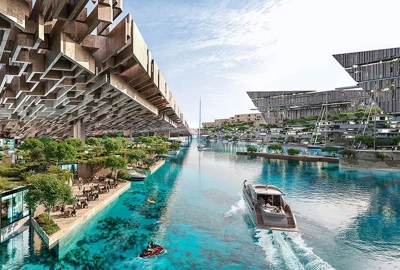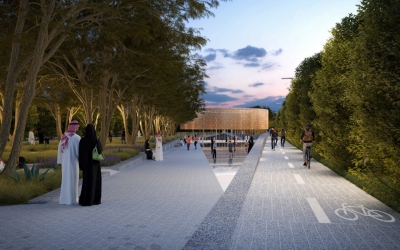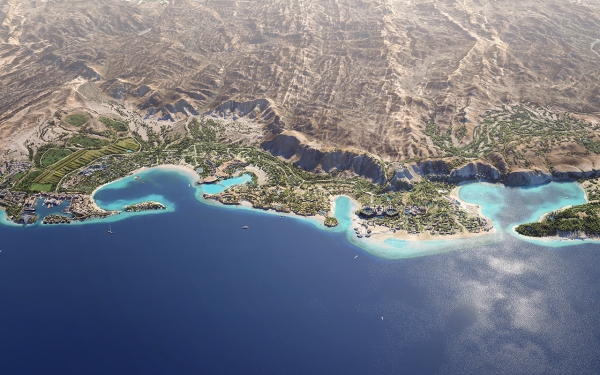
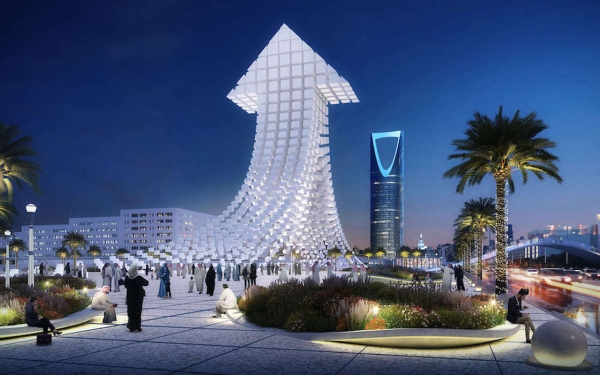
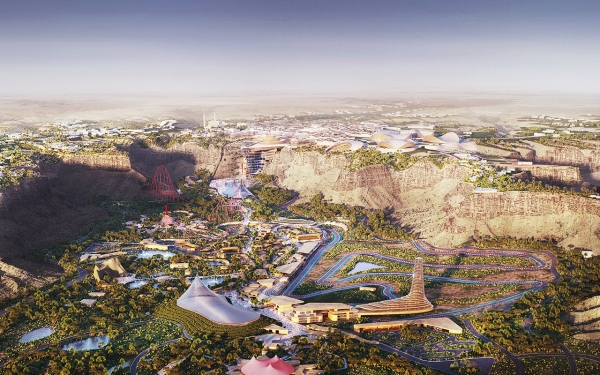
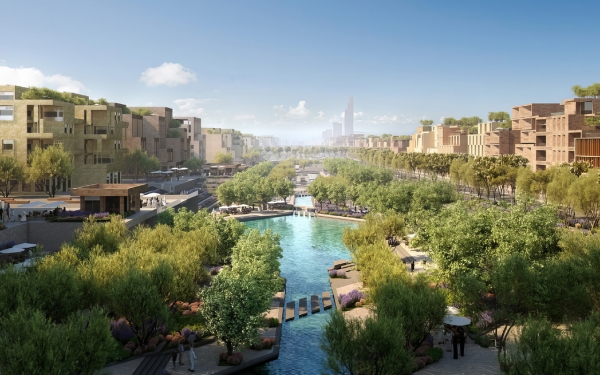
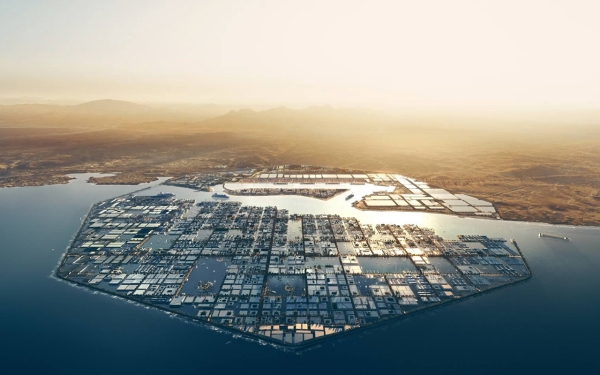
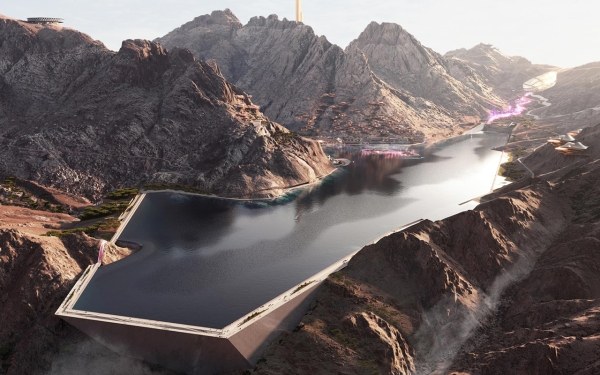
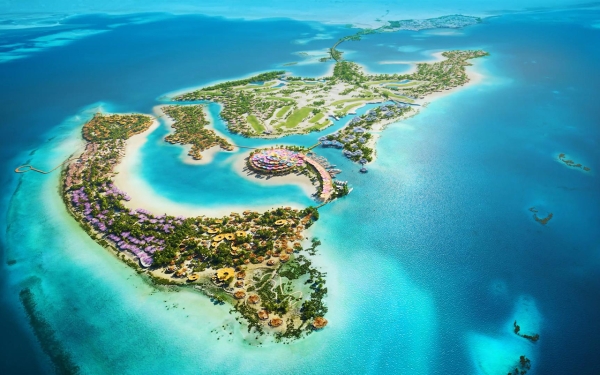
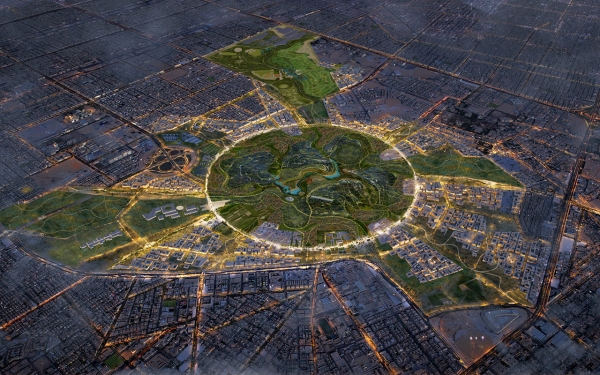

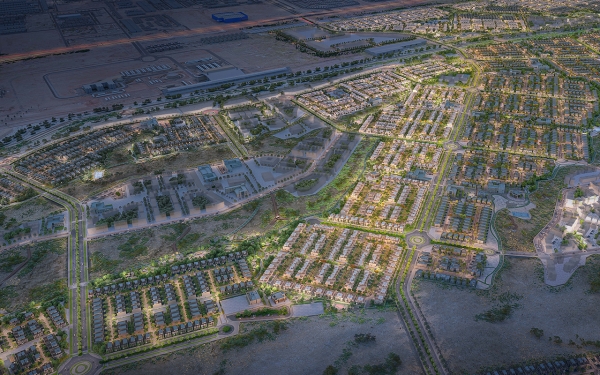
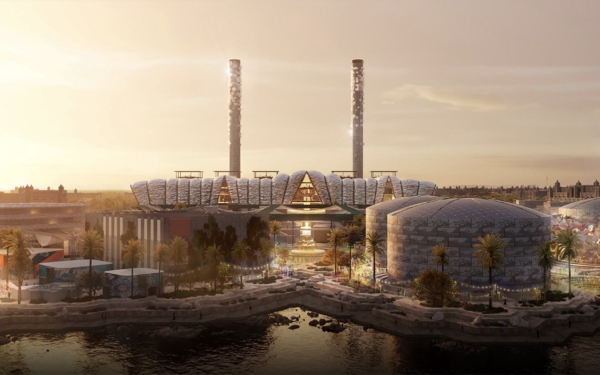
Saudi Megaprojects are a set of mega projects announced by the government of the Kingdom of Saudi Arabia for implementation after the launch of Saudi Vision 2030. They are described as mega due to the substantial budgets allocated to them, reaching billions of Saudi Riyals. These projects are of significant importance in economic, developmental, and social aspects, etc. They also have a local and international impact.
The megaprojects in Saudi Vision 2030 were categorized into several sectors, including energy, urban development, tourism, culture, housing, and healthcare.
Energy sector projects
The energy sector projects include:
It is one of the leading energy projects in the Kingdom, commenced in 2017 with the aim of designing, analyzing, testing, evaluating, and locally developing a new water desalination system in partnership with international organizations. The King Abdulaziz City for Science and Technology (KACST) provides technical support to the Saudi Water Authority for the construction of a hybrid and crystallization desalination plant, combining desalination, shared cooling, and salt crystallization system, all linked to a renewable energy source at the main desalination plant in
The Low Power Research Reactor project is one of the leading projects and the first of its kind in the Kingdom. It contributes to the design and development of the nuclear reactor industry in the Kingdom, the development and qualification of competencies, and the building of the human resources required to operate nuclear reactors and transfer its technologies, in line with Saudi Vision 2030. The aim is to diversify the sources of the economy and renewable energy. The reactor specifications were developed and designed by young national talents, along with the expertise of King Abdulaziz City for Science and Technology and with the participation of King Abdullah City for Atomic and Renewable Energy, and international experts.
Solar PV cell and module manufacturing plant and PV reliability laboratory
In 2010, King Abdulaziz City for Science and Technology (KACST) established a factory for the production of solar panels and cells as part of its efforts to enhance renewable energy systems in the Kingdom. In 2018, His Royal Highness Crown Prince Mohammed Bin Salman Bin Abdulaziz inaugurated the second phase of the project, representing a real industrial application of the research and development outputs in the field of solar energy produced by the laboratories of KACST. The city also established the world's first internationally accredited laboratory to test the efficiency and reliability of solar panels and developed standards that suit the Kingdom's environment.
Solar-powered water desalination project
To address water challenges and provision, the project was launched as part of the Custodian of the Two Holy Mosques initiative to desalinate saline water using solar energy to leverage the available solar resources. Crown Prince Mohammed Bin Salman inaugurated the project in 2018. It consists of a substation for desalinating water using reverse osmosis technologies and a substation for electricity production using solar photovoltaic panels.
Urban development sector projects
The urban development sector projects include:
Known as 'The Future Destination,' it is a project to establish a model city. It was announced on October 24, 2017, and it is located in the northwest of the Kingdom, covering an area of 26,500 km and extending across three countries. Furthermore, it is distinguished by its strategic location, serving as a converging hub for the Arab region, Asia, Africa, Europe, and America. Situated at a pivotal crossroads, it allows 40 percent of the world's population to reach it in less than four hours.
NEOM project comprises four main regions: Sindalah Island, The Line, Trojena, and Oxagon.
Sindalah Island
The Sindalah Island Project was announced in 2022. It represents the first luxury marine tourism destination in NEOM and is one of the key projects supporting the national tourism strategy. It was designed to serve as the main gateway for marine trips in the Red Sea and to offer one of the world's most significant experiences in hospitality and entertainment. It is expected that the island will start welcoming visitors at the beginning of 2024.
The project was announced in 2021. The Line City is characterized by its uniqueness and being free of streets and cars, resulting in zero carbon emissions. The city will be entirely powered by 100 percent renewable energy, and 95 percent of NEOM's area will be a protected natural reserve that remains untouched. The transportation and infrastructure will be designed to serve humans rather than the other way around, as is the case in traditional cities. The Line City will be two hundred m wide, 170 km long, and five hundred m above sea level. The Line will accommodate nine million people within a city built on an area of only thirty-four km.
It represents a global mountain tourism destination in NEOM. Announced in 2022, it is part of NEOM's plan and strategy to contribute to the support and development of the tourism sector in the region. Trojena is located at the heart of NEOM, about fifty km from the shores of the Gulf of Aqaba, in an area characterized by a range of the highest mountain peaks in the Kingdom, towering at around 2,600 m above sea level. It aims to attract more than seven hundred thousand visitors and around seven thousand permanent residents in Trojena and the adjacent housing sectors by 2030.
Oxagon, the industrial city of NEOM, is considered the world's largest floating industrial complex. Announced in 2021, its goal is to provide a new model for future manufacturing centers, in line with NEOM's strategy to redefine the way humanity lives and works in the future. Oxagon occupies a large area in the southwestern corner of NEOM, with the primary urban environment centered around the automated port. This integrated port and logistics service center will house the majority of the industrial city's population. The unique octagonal design of the city minimizes any environmental impacts.
The project was inaugurated, and its foundation stone was laid on April 28, 2018. It is one of the projects of the Public Investment Fund inspired by Saudi Vision 2030, representing the future capital for entertainment, sports, and the arts. Qiddiya is characterized by easy accessibility and is considered a strategic location. Additionally, it boasts unique natural landscapes, a historical area, and vast lands allocated specifically for the project.
Qiddiya project, spanning a total area of 376 km on the outskirts of Riyadh, is a leading future project. Its designated development area covers 223 km. Qiddiya's master plan comprises ten distinct zones. These include: One- Resort Core, Two- Motion Zone, Three- City Center, Four- Eco Zone, Five- Golf and Residential Community, Six- Aerodrome and Airfield, Seven- Future Development, Eight- Green Buffer, Nine- Arrival Point, Ten- Primary access to Qiddiya from Makkah Highway.
Qiddiya comprises three main sectors: entertainment, sports, and arts, each of which includes several areas. Entertainment: The entertainment sector includes dedicated attraction areas, such as parks and entertainment zones. It features Six Flags Qiddiya Park, which hosts thrill and amusement rides, alongside a water park and various entertainment-themed parks. The sector also incorporates retail, dining, and entertainment zones.
Wadi al-Disah development project
The Wadi al-Disah Development Project was announced in 2018. It is located within Prince Mohammed Bin Salman Natural Reserve and aims to preserve the environment and wildlife of the valley, while harnessing its tourism potential. Due to its geographic location centering NEOM, the Red Sea Project, Amaala, and al-Ula, the Wadi al-Disah area will provide additional tourism options. The Wadi al-Disah region rises to an elevation of four hundred m above sea level and is characterized by a diverse landscape of mountains and rocky cliffs, forming towering rock columns. It also boasts freshwater springs and contains various archaeological sites, including facades of Nabatean rock-cut tombs and remnants of walls inscribed with Nabatean and Arabic Kufic script.
Jeddah Central Project, previously known as New Jeddah Downtown
Jeddah Central Project, formerly known as New Jeddah Downtown, is one of the mega projects announced in 2017 as part of the Public Investment Fund's projects. The project's investment reached SAR18 billion. It is one of the projects that aims to revitalize the waterfront area in the center of Jeddah's Corniche, transforming it into a vibrant area and a unique tourist, residential, and commercial destination to rank Jeddah among the best hundred cities in the world.
In 2021, His Royal Highness Crown Prince Mohammed Bin Salman approved the general plan and main outlines of the Jeddah Central Project, with total investments amounting to SAR75 billion. These funds were allocated for the development of 5.7 million m and were financed by the Public Investment Fund and investors from both inside and outside the Kingdom.
The project aims to develop the historical area of Diriyah, which was inaugurated by the Custodian of the Two Holy Mosques, King Salman Bin Abdulaziz, in 2019. It has become one of the most important tourist, cultural, and human gathering destinations in the region and the world. The Diriyah Gate project is considered the jewel of the Kingdom and the largest heritage project in the world. The historical city of Diriyah shines a light on over three hundred years of the Kingdom's authentic culture and history.
At the heart of the project lies the historical al-Turaif neighborhood, which has been designated by UNESCO as a World Heritage Site. It is a neighborhood constructed from mudbrick and was the original home of Al Saud household in Diriyah, the first capital of the First Saudi State. The Diriyah Gate project contributes to the realization of Saudi Vision 2030 by aiming to attract twenty-seven million local and international visitors by 2030.
In 2021, Crown Prince Mohammed Bin Salman launched the design vision for the Journey Through Time Masterplan, a plan to develop al-Ula. Upon its completion in 2035, the development strategy is expected to contribute SAR120 billion to the Kingdom's gross domestic product (GDP).
The Journey Through Time Masterplan includes the development of five cultural districts by 2035. They are Old Town Oasis, Dadan Oasis, Jabal Ikmah Oasis, Nabatean Oasis, and Hegra Archaeological City. The project includes more than fifteen facilities and over five thousand hotel rooms. The length of the al-Ula Cultural Oasis is approximately nine km. Additionally, the project encompasses ten million m of green and public spaces, a valley, and stunning natural trails spanning twenty km. There is also an eco-friendly al-Ula tourist train that covers a distance of forty-six km.
The 'King Salman Park' project, announced in 2019, is the largest integrated environmental destination in the Kingdom. It was launched by the Custodian of the Two Holy Mosques King Salman Bin Abdulaziz as one of four qualitative megaprojects in Riyadh City, with a total investment of SAR86 billion. The project includes parks, green areas, and open spaces covering an area of over 9.3 million m. The King Salman Park project is located in a central hub in Riyadh City, connected to major highways, with access to train and bus stations in Riyadh.
The King Salman Park project is planned to become the green lung of Riyadh City, making it one of the world's largest urban parks with an area exceeding sixteen million m. The park aims to enhance Riyadh's global ranking as one of the best cities to live in the world and includes a 7.2 km pedestrian circular track, open spaces spanning over eleven m, and approximately one million trees covering the entire park area.
King Salman Energy Park (SPARK)
The King Salman Energy Park City (Spark,) located in the Eastern Province, was announced in 2018. It is envisioned as a global industrial ecosystem at the heart of the energy market that will become a global hub for energy, industry, and technology, covering an area of fifty km. The city is situated between the cities of Dammam and al-Ahsa in the Eastern Province and covers an area of twelve km in its first phase, with investments reaching approximately SAR6 billion.
Spark is also the world's first and only industrial city to achieve Leadership in Energy and Environmental Design (LEED) Silver certification in the energy and environmental design sector. Spark provides world-class infrastructure for international investors in the oil and gas sectors, the refining and petrochemical industries, and the energy and water production and processing industries. The construction of Spark is planned to be completed in three phases, covering an area of fourteen km, with the first phase expected to end in 2021. In addition to the aforementioned sectors, there is also a logistics services area and a dry port spanning three km within Spark.
Rua al-Madinah Project
In 2022, Crown Prince Mohammed Bin Salman launched the infrastructure and master plan for the 'Rua al-Madinah' Project in the area east of the Prophet's Mosque. The project aligns with the goals of Saudi Vision 2030, which is to increase the capacity to host thirty million pilgrims by 2030. It will be built on a total area estimated at 1.5 million m and aims to create 47,000 hospitality units by 2030.
The project adds at least SAR140 billion to the local economy and aims to enhance the services provided to pilgrims, Umrah performers, and visitors to al-Madinah al-Munawwarah as a modern Islamic and cultural destination. It relies on modern urban planning mechanisms, comprehensive development concepts, and advanced infrastructure to provide innovative services that improve the quality of life, enhance comfort and well-being, and enrich the experience of the residents and visitors of al-Madinah al-Munawwarah.
Tourism sector projects
The tourism sector projects include:
A luxurious tourist destination, it was launched on July 31, 2017. It is characterized by its strategic location, which will enable 250 million people to easily access it via a private airport within three hours. It is located along the western coast of the Kingdom between the governorates of al-Wajh and Umluj, spanning an area of 34,000 km. It includes an archipelago with approximately ninety pristine islands and stunning natural landscapes, mountains, canyons, dormant volcanoes, and deserts. By 2030, the destination will include fifty hotels with up to eight thousand hotel units and around a thousand residential properties, in addition to a private international airport for the destination.
The project is called the 'Middle East Riviera,' and it is a luxurious tourist destination focused on relaxation, health, and wellness. It was launched on September 26, 2018, and is located on the coast of the Red Sea within Prince Mohammed Bin Salman Nature Reserve. This reserve is situated at the heart of the stunning natural environment between the NEOM projects and the Red Sea Project. The project is surrounded by three unique directions and spans an area of 4,155 km, with an expected completion date of 2028.
Coral Bloom "Shurayrah Island"
One of the major tourism projects for which the design vision was unveiled in 2021 is Shurayrah Island, which serves as the main gateway to the Red Sea Project. The island is planned to include eleven resorts and hotels operated by renowned international hospitality brands. The natural scenery will be leveraged to create a dramatic effect for these facilities, especially since all the island's hotels and villas consist of a single floor, seamlessly integrated with the sand dunes, ensuring the preservation of the surrounding natural beauty without any obstruction to the view.
Shura Island, which resembles a dolphin in shape, is one of the islands in the Red Sea Project. It is home to a wide variety of unique animals and plant species. The island is set to welcome visitors in 2024, as it includes eleven hotels and resorts from world-class international hospitality brands, such as Edition Hotels, Fairmont Hotels and Resorts, Raffles Hotels and Resorts, SLS Hotels and Residences, InterContinental Hotels and Resorts, Jumeirah Group, Miraval, Rosewood, and Grand Hyatt.
In 2021, Crown Prince Mohammed Bin Salman launched Soudah Development Company in Aseer Province, with expected investments exceeding SAR11 billion. The company, wholly owned by the Public Investment Fund, aims to invest in infrastructure and develop the tourism and entertainment sectors. It focuses on the development of the project area, including al-Soudah and parts of the Rijal Almaa Governorate, to transform it into a luxurious mountainous tourist destination known for its authentic culture, unique heritage, and enchanting natural surroundings.
Cultural sector projects
The cultural sector projects include:
Prince Mohammed Bin Salman Project for the Development of Historical Mosques
Prince Mohammed Bin Salman Project for the Development of Historical Mosques is one of the leading cultural projects in Saudi Vision 2030. It was announced in 2018 and includes the rehabilitation and restoration of 130 historical mosques in various regions of the Kingdom. The project enhances the Kingdom's service to the houses of God and contributes to highlighting the cultural dimension emphasized by Saudi Vision 2030. It does so by preserving authentic urban characteristics and utilizing them in the development of modern mosque designs.
The project was launched on March 15, 2019, with the aim of transforming the capital, Riyadh, into an open-air art gallery. It involves the execution of approximately one thousand artistic works and landmarks created by local and international artists throughout various areas of Riyadh. This project constitutes one of the largest public art projects in the world and includes ten programs covering residential neighborhoods, parks, public squares, public transport stations, road bridges, pedestrian bridges, and all tourist destinations in Riyadh. The project is expected to be completed by late 2023.
Sports Boulevard Project
The project, which includes sports, art, cultural, entertainment, and environmental activities, was launched on March 15, 2019. Its goal is to transform Riyadh into a sports city, providing its residents with various venues, roads, and parks for sports activities. The project comprises eight boulevards connecting Wadi Hanifa and Wadi al-Sulai with extended areas along the boulevard with a total length of up to 135 km. The project is expected to be completed in 2027.
Housing sector projects
The housing sector projects include:
The megaprojects have shaped the housing sector, where ROSHN was established as a national real estate development company aimed at developing residential neighborhoods with high-quality standards that align with the aspirations of Saudi society. It aims to capitalize on the opportunities available in the real estate market due to the increasing demand for housing in the Kingdom. Additionally, it contributes to increasing the homeownership rate to 70 percent over the next ten years, aligning with the goals of Saudi Vision 2030.
Healthcare projects
Healthcare megaprojects include:
The Saudi Genome Program is considered one of the leading projects of Saudi Vision 2030, aimed at supporting the national transformation towards an innovation-based economy. Its goal is to reduce genetic diseases using advanced genome technologies. The program aims to create a database to document the first genetic map of the Saudi population, advance the field of personalized medicine, and reduce healthcare costs by harnessing the latest technologies to provide better diagnosis, treatment, and prevention.
Related quizzes
Related articles

